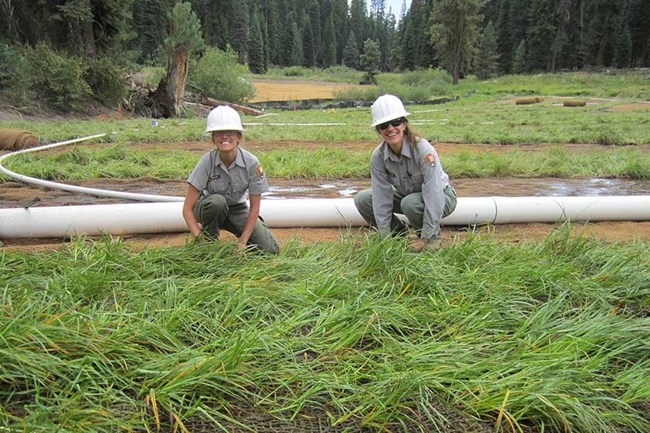
NPS Photo
About Watershed Restoration
Watersheds are areas of land where all water drains to a common waterway, such as a lake, river, or ocean. As the water runs through the watershed, it will pick up and carry with it all materials, like sediment or nutrients from the soil, present in the drainage basin. It is thus extremely important to keep these areas clean and protected. Human pollutants, like those from farm fertilizers, pesticides, and sewage, can make their way into a watershed and then drain to and pollute the waterway at the end of the drainage basin, causing problems such as algae bloom and fish deaths. Pollution from watersheds can also result in unsafe drinking water, making it necessary to use costly treatments to make the water fit for human consumption again.As a volunteer, you can help keep our park watersheds clean through revegetation (replanting a designated area), which can help prevent both excess erosion, by stabilizing shorelines, and also pollutant accumulation, since plants can act as filters or buffers that help to reduce the amount of runoff that drains to a waterway.
About Wetland Restoration
Wetlands, unique environments that include swamps, marshes, fens, and bogs, serve as links between watersheds and the water to which they drain. A healthy wetland can actually catch and hold pollutants and other runoff materials before they reach a lake, river, or ocean. Wetlands also provide flood control and serve as an important breeding and nursery habitat for a large array of wildlife and marine species. Too much pollution, however, or an increase in human activity that harms the health of the wetland (such as draining, construction, or harvesting), can severely damage this unique environment, resulting in the loss of the many benefits that wetlands can provide.Because of these threats, many of our nation’s wetlands have become unhealthy or have even been destroyed – in fact, less than half of the wetlands that previously existed in the lower 48 states remain today. Invasive species have replaced native plants and animals as a result, disrupting the natural balance of the ecosystem and making it impossible for the wetland to recover unaided. That’s where you come in! As a volunteer at a ocean, coastal, or Great Lakes park, you can help to restore damaged wetlands by removing invasive plants, planting native trees and shrubs, and helping with the construction of landscape features to re-establish natural water flow. Together we can help revive these areas and protect the precious resources that they contain.
The kinds of work available in a watershed or wetland restoration project can vary widely; some jobs might be better suited for a certain skill set or age group. Be sure to check beforehand with the park you plan on visiting to see if they have an opportunity that suits your interests.
For Further Reading
NPS WetlandsNPS Watersheds
EPA Information on Watersheds
Volunteer
Get Involved
Last updated: December 9, 2021
